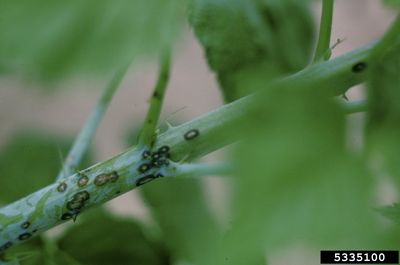Anthracnose can cause poor fruit quality and production, and in severe infections, weaken or even kill canes. Dieback, cane spot, and gray bark are other names commonly used for blackberries with anthracnose.
Symptoms of Blackberries with Anthracnose
The first signs of a blackberry anthracnose infection will be in the spring, usually on the shoots of the new canes. Small purple spots will appear, which will increase in size, become oval-shaped, and eventually turn a gray or buff color. You may also find small spots with light gray centers and purple margins on the leaves. In heavy infections, the spots on the canes and stems can grow in numbers and merge together, covering the canes and appearing as large cankers with cracks. This can girdle the cane, causing dieback.
Causes of Anthracnose of Blackberries
This disease is caused by the fungus Elsinoe veneta. It overwinters in diseased canes and then releases spores during rainy periods the following spring and summer. The greatest risk of it infecting blackberries is between bud break and pre-harvest, as the fungus targets mainly the new growth.
How to Treat Blackberries with Anthracnose
The recommended blackberry anthracnose treatment is quite easy.
If you are planting a new blackberry patch, make sure to properly space and prune your plants. Erect varieties of berries are less susceptible to anthracnose than spreading types. Remove any wild brambles in the area, which can harbor the disease. Remove weeds in your berry patch and prune back blackberry bushes to promote good air circulation and light penetration. This will allow faster drying of foliage and canes. After harvesting blackberries, and during the dormant season, remove and destroy any canes that have been infected.
These cultural practices may be sufficient to control blackberries with anthracnose but using a delayed dormant spray may also be necessary. Before growth starts and while temperatures are still cold, apply a lime, sulfur, copper hydroxide, or a foliar fungicide. The recommended type may vary depending on your area, so check with your county extension office for the latest information.
